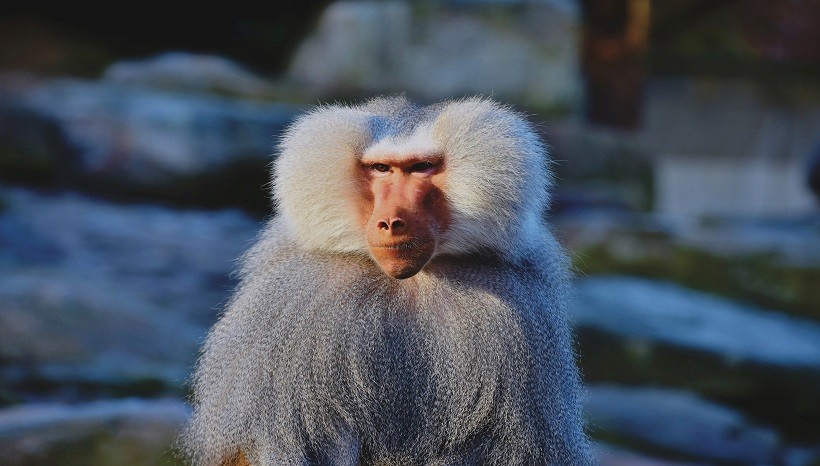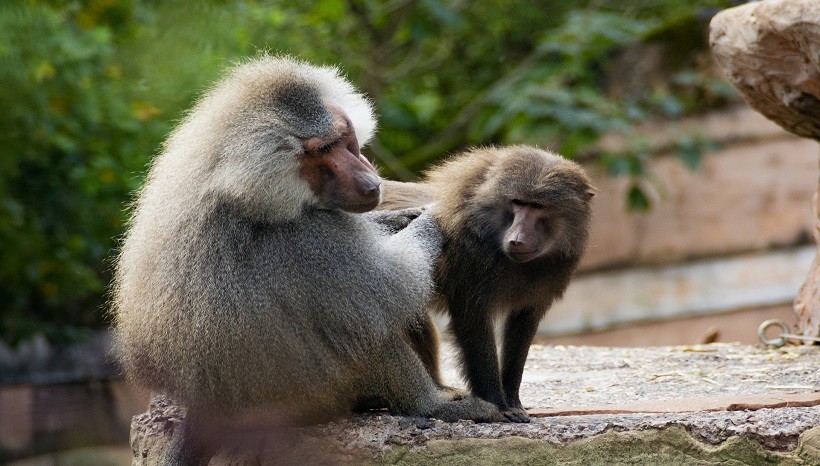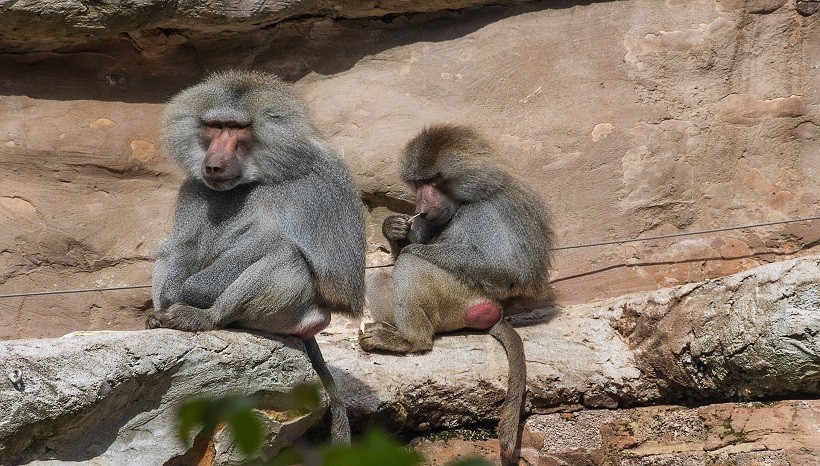The Hamadryas baboon, scientifically known as Papio hamadryas, is a remarkable and highly adaptable species of Old World monkey that has captured the attention of researchers, wildlife enthusiasts, and conservationists alike. Found in the arid regions of the Horn of Africa and the southwestern tip of the Arabian Peninsula, these social primates exhibit intriguing behavior, a complex social structure, and remarkable physical adaptations. In this article, we will delve into the world of Hamadryas baboons, exploring their habitat, behavior, social structure, and the challenges they face in the wild.
Habitat and Range
Hamadryas baboons are primarily inhabitants of arid and rocky landscapes. They are highly adaptable and can be found in a variety of habitats, including semi-desert areas, mountainous terrain, and coastal cliffs. Their range extends from the southwestern part of Saudi Arabia across the Red Sea into Eritrea, Ethiopia, Djibouti, and Somalia.
Hamadryas Baboon prefers to make the home on the high cliffs. This monkey lives in different habitats including plains, steppe, arid brushland, sub desert and savanna. They prefer to make their home at the high cliffs where the monkey can gain water sources, acacia, opuntia cactus.
Physical Characteristics
Hamadryas baboons are among the largest of the baboon species, with males typically larger than females. They exhibit distinct sexual dimorphism, with males weighing between 40-45 pounds (18-20 kg) and females weighing around 20-25 pounds (9-11 kg). Their fur coloration varies, with males often sporting a silver-gray cape and females having a more olive-brown coat.
One of the most striking features of these baboons is their expressive face, characterized by a hairless, pink face and a long, sharp snout. This unique facial structure sets them apart from other baboon species and gives them a distinctive appearance.
Behavior and Social Structure
Hamadryas baboons are renowned for their complex and tightly-knit social structure. They live in multi-level societies composed of troops, clans, and bands. Troops are the largest social units, consisting of multiple harems led by a dominant male, known as the “leader” or “alpha.” Each harem typically includes several adult females and their offspring.
Male leadership within a troop is maintained through a combination of physical prowess and social skills. The leader is responsible for protecting his harem from external threats, such as predators or rival males. Female baboons often form strong bonds with their offspring and engage in grooming and social activities within their harems.
Clans are groups of troops that associate and interact with one another, particularly during foraging. Bands are the smallest social units, composed of a few adult females and their offspring. They often forage separately from the larger troops and clans.
The monkey is active during the daytime and sleeps at night. Right after sunrise, the monkey groups gather together for the monkeys around. In this gathering, they play, chase, and groom in one male unit called a social group.
Communication
Hamadryas baboons are highly vocal and use a wide range of vocalizations to communicate within their social groups. These vocalizations include barks, grunts, and screams, each serving a specific purpose, such as warning of predators or maintaining social cohesion.
Additionally, these baboons communicate through grooming and various body postures, reinforcing social bonds and hierarchies within their troops.
Diet and Foraging
Their diet is diverse and opportunistic, consisting of a wide range of plant material, including leaves, fruits, and seeds, as well as insects and small vertebrates. Their ability to adapt their diet to the available resources in their arid habitats demonstrates their remarkable survival skills.
The Baboon Diets include:
Challenges and Conservation
While Hamadryas baboons are not currently considered endangered, they face several challenges in the wild. Habitat destruction due to human encroachment, overgrazing by domestic livestock, and the illegal pet trade are some of the threats to their populations.
Conservation efforts are essential to safeguard these unique primates. This includes habitat protection, monitoring of populations, and public awareness campaigns to discourage illegal wildlife trade.
Hamadryas Baboon Facts

Following are the facts of Baboons Monkey:
- The male monkeys yawn by exposing their canine teeth that are 4 cm long when threatened.
- They love to groom each other and enhance their relationship with others in their community.
- The Hamadryas Baboon plays a significant role in the folklore plus art of ancient Egypt.
- In old times this monkey was considered as the God Of Learning representative.
- The ancient Egypt royals used to keep them as a pet.
- They use their body language to communicate. Gestures like smiling, staring and head bobbing are used for threats while lip-smacking and nose-touching are used to show friendly behavior.
- Whenever the male baboon sees any predator nearby, it produces a dog-like bark to alert others.
Hamadryas Baboon Habitat
Male Hamadryas Baboon

The male monkey is covered with brown or light grey fur. They have long silvery hair on the mane with a bright pink face and back. It has a small non-prehensile tail. The male monkey weight is 20-30 kg.
Hamadryas Baboon Size
Their body length is 40-45 cm while their weight is 20-30 kg(male) and 10-15 kg(female).
Hamadryas Baboon Lifespan
The Baboons Monkey can live for 20 years.
FAQ’S
1. Where are hamadryas baboons found?
One can find them in southwestern Arabia, Yemen and Saudia Arabia.
2. Are hamadryas baboons endangered?
They are not endangered yet.
3. Are baboons dangerous?
They are not dangerous for humans but can attack dogs but have a habit of terrifying women while searching for food in urban areas.
Conclusion
The Hamadryas baboon is a fascinating species that thrives in the challenging environments of the Horn of Africa and the Arabian Peninsula. Their intricate social structure, remarkable physical adaptations, and ability to adapt to harsh conditions make them a subject of great interest to researchers and wildlife enthusiasts. By understanding and conserving these remarkable creatures, we can contribute to the preservation of biodiversity and the rich tapestry of life on our planet.
We've discussed the hamadryas baboons belong to the old world monkeys. They live in different areas including semi-deserts, savannas and rocks. The monkey is not dangerous for humans, and Egypt royals used to keep them as a pet. However, females can get frightened by them in urban areas. We've mentioned all the details related to this specie above.
{ "@context": "https://schema.org", "@type": "Article", "mainEntityOfPage": { "@type": "WebPage", "@id": "https://petshoods.com/hamadryas-baboon-facts-habitat/" }, "headline": "Hamadryas Baboon Facts, Habitat and All Information", "description": "Hamadryas Baboon is an old world monkey. The ancient Egypt royals used to keep them as pets. They have brown or light gray fur and can live upto 20 years.", "image": "https://petshoods.com/wp-content/uploads/2020/08/Hamadryas-Baboon-Facts-Habitat-Behavior-and-All-Information-768x436.jpg", "author": { "@type": "Person", "name": "jeremy" }, "publisher": { "@type": "Organization", "name": "Petshoods", "logo": { "@type": "ImageObject", "url": "https://petshoods.com/wp-content/uploads/2019/02/13925402_1502331219793083_1620090286454245017_n.jpg" } }, "datePublished": "2020-08-19", "dateModified": "2021-07-13" } { "@context": "https://schema.org/", "@type": "ItemList", "itemListElement": [ { "@type": "ListItem", "position": 1, "name": "Hamadryas Baboon Facts", "url": "https://petshoods.com/hamadryas-baboon-facts-habitat/#Hamadryas_Baboon_Facts" }, { "@type": "ListItem", "position": 2, "name": "Hamadryas Baboon Diet", "url": "https://petshoods.com/hamadryas-baboon-facts-habitat/#Hamadryas_Baboon_Diet" }, { "@type": "ListItem", "position": 3, "name": "Hamadryas Baboon Habitat", "url": "https://petshoods.com/hamadryas-baboon-facts-habitat/#Hamadryas_Baboon_Habitat" }, { "@type": "ListItem", "position": 4, "name": "Hamadryas Baboon Behavior", "url": "https://petshoods.com/hamadryas-baboon-facts-habitat/#Hamadryas_Baboon_Behavior" }, { "@type": "ListItem", "position": 5, "name": "Male Hamadryas Baboon", "url": "https://petshoods.com/hamadryas-baboon-facts-habitat/#Male_Hamadryas_Baboon" }, { "@type": "ListItem", "position": 6, "name": "Hamadryas Baboon Size", "url": "https://petshoods.com/hamadryas-baboon-facts-habitat/#Hamadryas_Baboon_Size" }, { "@type": "ListItem", "position": 7, "name": "Hamadryas Baboon Lifespan", "url": "https://petshoods.com/hamadryas-baboon-facts-habitat/#Hamadryas_Baboon_Lifespan" } ] } { "@context": "https://schema.org", "@type": "FAQPage", "mainEntity": [{ "@type": "Question", "name": "Where are hamadryas baboons found?", "acceptedAnswer": { "@type": "Answer", "text": "One can find them in southwestern Arabia, Yemen and Saudia Arabia." } },{ "@type": "Question", "name": "Are hamadryas baboons endangered?", "acceptedAnswer": { "@type": "Answer", "text": "They are not endangered yet." } },{ "@type": "Question", "name": "Are baboons dangerous?", "acceptedAnswer": { "@type": "Answer", "text": "They are not dangerous for humans but can attack the dogs but have a habit of terrifying women while searching for food in urban areas." } },{ "@type": "Question", "name": "What is a hamadryas Baboon Lifespan?", "acceptedAnswer": { "@type": "Answer", "text": "It has an average lifespan of 20 years." } }] }
